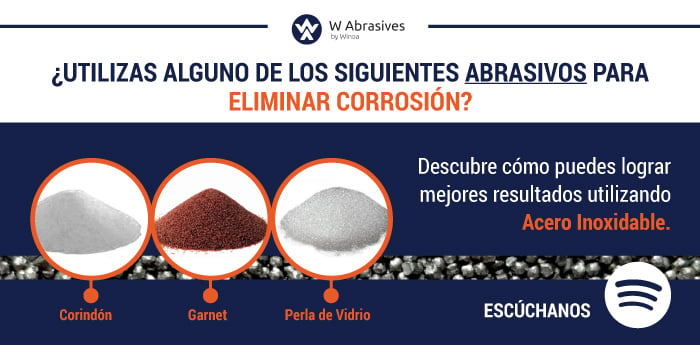
On this occasion we have to talk about energy since the process of shot blasting a piece is done by transmitting kinetic energy to an area.
The formula tells us that the kinetic energy is equal to one half of the mass times the speed squared, that is to say that the variables here would be the mass, which is the size of the particle and the quantity that is thrown plus the speed, since either the particles are blown by means of a wheel or by air pressure through nozzles in an airblast system.
The particles are accelerated through these media to transmit that energy and do the cleaning work; Another very important variable is the hardness of the particle, and in the case of steel abrasive, it is defined by the amount of carbon it contains.
Therefore, there are two types of abrasives on the market: low and high carbon steel. But how do we know which one suits us best?
Manufacturers of low carbon shot may claim that their product is better than high carbon shot with claims such as:
- The grit lasts longer.
- Less machine wear (longer life of wear parts).
- Shot blasted surfaces are brighter.
But here are some facts:
The use of steel abrasives with high carbon content results in:
- Greater shot blasting efficiency, therefore, abrasive consumption per shot blasted parts is lower.
- Reduced costs, including energy, labor, spare parts, etc., due to higher productivity.
- A cleaner surface, not a glossier one. Gloss is not a cleaning standard.
In general, a typical operation using a high carbon abrasive can increase blast efficiency by up to 20% compared to a low carbon product.
Due to the higher intensity of the high carbon steel abrasives, more energy is transferred to the component and not to the abrasive. A low carbon abrasive will absorb a lot of energy upon impact.
High carbon provides 43% more energy than low carbon.
Two particles of the same size (one high carbon and one low carbon) contain the same amount of potential energy, but due to the high carbon content its hardness is higher so it will transfer more kinetic energy to the work piece. The result is that the particle with the higher carbon content cleans faster.
A smaller particle size with high carbon content can transfer as much or even more energy than a large particle with low carbon content. And even better coverage can be achieved.
A smaller size high carbon shot can be used in the process. The small abrasive has a lower consumption rate as it hits the part with less impact and is subject to less fatigue stress.
A smaller number of high-carbon particles can transfer more energy than a larger number of low-carbon particles. As a result the amount of thrown abrasive can be reduced (this can be seen through the amperages of a wheel) and at the same time cleanliness can be improved.
The rebound effect (coefficient of restitution) is much greater with high carbon content particles than with low carbon content material. Result: High-carbon abrasives cleans faster, especially in areas that don't receive direct impact like the internals of castings.
Since low carbon shot is not quenched within the manufacturing process, oxides and contaminants formed during atomization are not removed. Therefore, conductivity levels are higher than high carbon abrasives. Result: Chlorides are more easily transferred to the work piece, causing possible surface contamination.
The reality is that, although it is argued that low carbon is more resistant, it is definitely less efficient in transmitting energy to the surface, so the blasting time will need to be increased to achieve the same cleanliness. Also, it is not available in angular form due to the softness of the material.
Many low-carbon manufacturers claim that this technology is very popular and can compete against high-carbon, but because its market appearance against high-carbon is only 10%
In short, it's a mild abrasive, with erratic internal quality, but luckily they're only the 10% to buy it.
W Abrasives, with 60 years in the market, has the necessary knowledge and experience to help you select the steel abrasive for your blasting applications, but above all to help you better understand your process and thus improve and make it more efficient. Do not hesitate to contact us for specialized advice, acquire tools that help control the process or obtain training.






